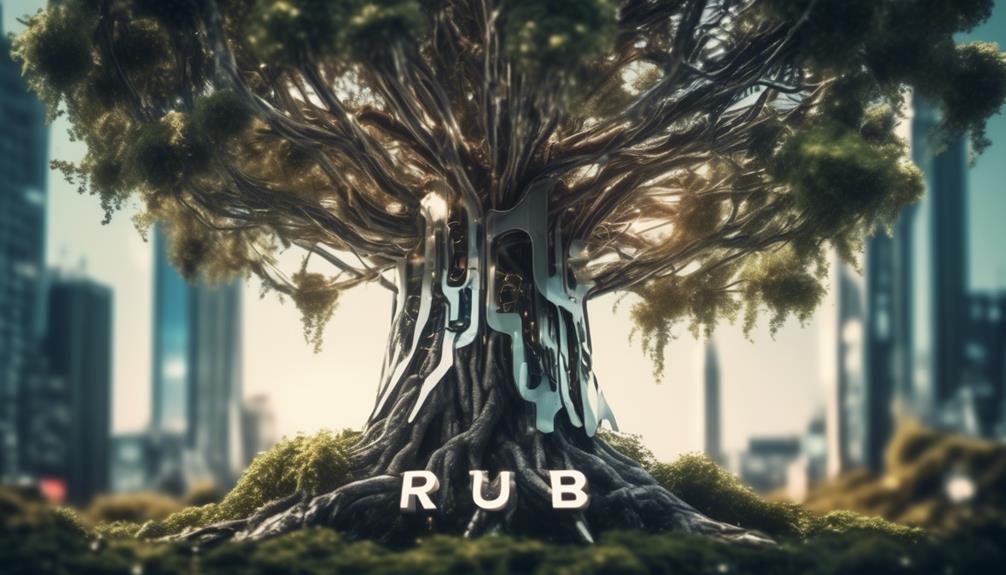
You might not be aware that Rumble, a lesser-known video-sharing platform, has been steadily carving out its niche in the crowded digital content landscape since 2013.
In direct contrast to the dominant player, YouTube, Rumble prides itself on providing a platform that champions free speech and content transparency, while also offering a more lucrative revenue-sharing model for creators.
It's an intriguing alternative, isn't it? But, as you've just scratched the surface of this comparison, you're likely wondering what other advantages Rumble might offer.
We'll further dissect these differences, exposing the unique benefits this platform brings to the table.
Key Takeaways
- Rumble prioritizes fair and transparent revenue sharing, offering a more lucrative monetization model for video content creators.
- Rumble maintains clear and transparent policies, reducing the risk of unjustified takedowns and strikes compared to YouTube.
- Rumble takes a hands-off approach to censorship, allowing a wider range of content and diverse perspectives to thrive on the platform.
- Rumble offers a user-friendly interface, intuitive navigation, and a balanced content discovery algorithm that promotes diverse content and provides a superior user experience compared to YouTube.
Understanding Rumble's Origin

To truly grasp the Rumble versus YouTube debate, it's crucial to first understand how Rumble came into existence. In 2013, Chris Pavlovski, a visionary in the digital space, founded Rumble with the aim of revolutionizing the way video content creators could earn from their work. He saw a gap in the market for a platform that prioritized creators' needs and rights, and thus Rumble was born.
Unlike YouTube, Rumble focuses on providing a fair and transparent revenue model for creators. It's not just about hosting videos; it's about building a supportive community that values creator contributions. Rumble's unique monetization model allows content creators to earn more for their videos, pushing the boundaries of what's considered the norm in the industry.
You see, Rumble's transformative approach to video content monetization represents a significant shift away from the established norms set by platforms like YouTube. It offers an alternative pathway for creators, one that's more equitable and transparent.
This understanding of Rumble's origin provides an essential context in the ongoing debate between Rumble and YouTube. It's no longer just about where to host videos, but about which platform truly values and rewards creators' efforts.
Rumble's Content Moderation Policies
Building on the foundation of being a creator-centric platform, Rumble's content moderation policies also stand out as a distinguishing factor in the comparison with YouTube.
While YouTube's content moderation policies have often been criticized for being overly restrictive and even biased, Rumble offers a more liberal approach. It's designed to give creators the freedom they need to express their views and share their content without undue censorship.
However, this isn't to say that Rumble doesn't have rules. It does, but they're predicated on maintaining a safe, respectful environment for all users. You'll find that Rumble's policies are clear, transparent and designed to foster a healthy community. For instance, hate speech, harassment, and misinformation aren't tolerated.
Moreover, Rumble's moderation isn't automated like YouTube's. They review content on a case-by-case basis, giving each video the attention it deserves. This reduces the risk of unjustified takedowns and strikes, allowing your content to thrive.
In essence, Rumble's content moderation policies are innovatively designed to balance freedom of expression with community safety. This offers you an appealing alternative to platforms with more restrictive policies.
Freedom of Speech on Rumble

You might be wondering about Rumble's stance on freedom of speech. Looking at their censorship policies, it seems they're making a conscious effort to foster a platform that supports diverse opinions.
This analysis will further explore how Rumble manages to balance freedom of speech and content moderation.
Rumble's Censorship Policies
When it comes to Rumble's censorship policies, they're markedly different from those of YouTube, boasting a stronger commitment to freedom of speech. Rumble takes a hands-off approach, allowing a wider range of content, catering to your innovative spirit. You'll find it provides a platform for diverse perspectives to thrive.
To illustrate the difference, consider this table:
| Platform | Censorship Stance | Content Range |
|---|---|---|
| Rumble | Less restrictive | Wide |
| YouTube | More restrictive | Narrowed |
Rumble is less likely to remove or demonetize videos, while YouTube often limits content that doesn't align with its guidelines.
| Platform | Monetization Impact | Freedom of Speech |
|---|---|---|
| Rumble | Low | High |
| YouTube | High | Limited |
Promoting Diverse Opinions
Given Rumble's commitment to a less restrictive censorship policy, it naturally fosters an environment where diverse opinions can flourish, embodying the true spirit of freedom of speech.
This platform enables you to express your views without fear of retribution or suppression, which can often be the case on YouTube.
Rumble's unique algorithm doesn't favor mainstream narratives but instead promotes a balanced blend of viewpoints. This means your content has an equal chance of gaining visibility, regardless of its perspective.
It's a breath of fresh air in the digital age, where innovation is often stifled by rigid algorithms and biased content moderation.
In essence, Rumble provides a catalyst for thought-provoking discussions and genuine content diversity, outpacing YouTube in promoting free speech.
User Privacy on Rumble
Let's turn our attention to 'User Privacy on Rumble'.
You might be curious about Rumble's data protection policies and how they stack up in comparison to YouTube. These are critical aspects to understand, as they directly impact your online privacy and security.
Rumble's Data Protection Policies
You might be wondering how Rumble, as an alternative to YouTube, handles user privacy and data protection. Well, Rumble has carved a niche for itself in this sector, offering robust data protection policies designed to safeguard user privacy.
Rumble has a transparency policy, which means they're upfront about the data they collect and how it's used.
They've a strict no-third-party policy. Your data won't be shared with any third party without your explicit consent.
Their security measures are top-notch. They employ advanced encryption techniques to protect your data from unauthorized access.
Rumble's commitment to privacy and data protection is evident in these policies. As you seek innovative platforms, Rumble's approach to user privacy offers a refreshing change from the norms.
Privacy Comparison: Rumble Vs Youtube
When comparing Rumble's approach to user privacy with that of YouTube, it's clear that there are some significant differences to consider.
Rumble prioritizes your privacy by allowing content creators to maintain rights over their materials. Unlike YouTube, which often uses your data for targeted advertising, Rumble's privacy policy is more user-centric. They're less likely to share your personal information with third parties, making it a more secure platform. They also give you the option of anonymizing your viewings and likes.
This focus on user privacy and control is part of what sets Rumble apart and makes it a compelling alternative to YouTube. So, if you're seeking a platform where your privacy is respected, Rumble might be your go-to choice.
Rumble's Compensation Model for Creators

In contrast to YouTube, Rumble offers a unique compensation model that significantly benefits its creators. You're not just paid based on the ad revenue generated by your content, but also for the rights to distribute it. This means that when you upload a video, Rumble takes on the task of getting it out there to viewers, and you get a share of the revenue from the get-go.
Here are a few key points that make Rumble's compensation model stand out:
- It's not solely based on ad revenue. Rumble pays creators for the rights to distribute their content, offering a revenue stream from the moment you upload.
- Rumble's algorithm isn't as restrictive as YouTube's. This means they're more likely to promote a wider range of content, potentially leading to more views and earnings.
- Rumble has a partnership program that allows creators to earn revenue from multiple sources, further diversifying their income.
Rumble's innovative compensation model shows they truly value content creators. It's not just about making money from ads, but about partnering with creators to ensure their work gets the recognition it deserves.
In a digital landscape that's constantly evolving, Rumble's approach offers a refreshing alternative.
Monetization Opportunities on Rumble
Let's turn our focus to the monetization opportunities on Rumble.
You'll find it rewarding to understand Rumble's unique revenue model, which offers a distinct approach compared to Youtube.
This contrasting analysis will provide you with an expanded understanding of how content creators can effectively earn on Rumble.
Rumble's Rewarding Revenue Model
You'll find that Rumble's rewarding revenue model presents a wealth of monetization opportunities, setting it apart from other platforms like YouTube. This innovative platform offers a more fair and transparent revenue sharing system, giving content creators a better chance to earn from their videos.
Rumble's notable features include:
- Revenue Share: Rumble offers up to 60% of ad revenue to creators, an impressive increase compared to YouTube's 45%.
- Video Licensing: You can choose to license your content, opening additional revenue streams from Rumble's syndication partners.
- Monetization Control: Rumble gives you control over your video's monetization settings, ensuring your content is monetized in ways that suit your needs.
Understanding Rumble's Monetization Process
Now that we've highlighted Rumble's unique features, it's crucial to delve deeper into its monetization process to fully grasp the potential earning opportunities this platform offers.
Unlike YouTube, Rumble doesn't solely depend on ad revenue. You've options to earn via licensing revenue, video management, and direct sales.
When you upload a video, Rumble's algorithm assesses its potential and may offer a licensing deal, which can be significantly lucrative.
Video management, on the other hand, allows Rumble to distribute your content across multiple platforms, boosting views and revenue.
Lastly, direct sales let you sell your videos on Rumble's marketplace.
With its innovative approach, Rumble provides diverse income streams, offering creators more control and financial prospects.
Comparing Youtube and Rumble
While Rumble's monetization opportunities are undeniably diverse, it's essential to compare them with what YouTube, a more established platform, offers to truly understand their relevance and potential.
Rumble provides a refreshing alternative with its revenue-sharing model. Unlike YouTube's strict monetization rules, Rumble's less stringent policies offer a lucrative avenue for creators of all sizes. Here are some key differences:
- Rumble shares ad revenue from day one; YouTube requires a minimum of 1,000 subscribers and 4,000 watch hours.
- Rumble offers revenue from multiple sources: ads, licensing, video management.
- Rumble's algorithm is more creator-friendly, focusing on content discovery rather than user history.
In essence, Rumble is an innovative platform that respects creators' efforts and provides diverse earning opportunities. It's time to venture into new platforms and maximize your creative potential.
Rumble's User Interface: A Comparison
In comparison to YouTube, Rumble's user interface presents a unique blend of simplicity and functionality that's worth exploring. It's not cluttered with excessive features, making navigation a breeze. The homepage is straightforward and user-friendly, with trending videos highlighted for easy discovery.
Let's break down this comparison into more detail:
| Feature | Rumble vs YouTube |
|---|---|
| Interface | Rumble's simplistic design is less overwhelming than YouTube's cluttered interface. |
| Navigation | Rumble's intuitive navigation makes it easier for users to find their desired content. |
| Content Discovery | On Rumble, trending videos are prominently displayed, enhancing content discovery. |
| Customization | Rumble allows greater control over content feed, compared to YouTube's algorithm-dictated feed. |
Rumble's interface is designed with the user experience in mind. It's not just about watching videos; it's about creating an environment where you can engage with content that suits your taste. Rumble's aim is to provide a platform that's not only efficient but also enjoyable to use. It's a refreshing change for those seeking a novel video-sharing platform. If you're interested in innovation, Rumble might be the perfect fit for you. Its user interface sure makes it stand out from the crowd.
Rumble's Video Discovery Algorithms

Diving deeper, let's examine how Rumble's video discovery algorithms work to deliver content that aligns with your interests.
Unlike YouTube, whose algorithms heavily rely on user activity and often promote videos from popular channels, Rumble takes a different approach. It uses a more balanced system, taking into consideration not just trending content, but also giving equal opportunity to less popular creators.
This innovative approach ensures that:
- You're exposed to a diverse range of content, not just what's deemed popular.
- Smaller creators have a fair chance at visibility, encouraging a more vibrant, diverse creator community.
- The content delivered aligns closely with your interests, rather than what's trending globally.
Moreover, Rumble's algorithms are designed to be transparent, providing an insight into why certain videos are recommended. This transparency is a breath of fresh air in an industry where algorithms are often mysterious and opaque.
Rumble's video discovery algorithms are a key component in the platform's commitment to delivering a superior user experience. They're designed to facilitate your exploration of novel content, promoting a diverse, balanced, and interest-centric viewing experience.
This innovative approach sets Rumble apart and could be the game-changer in the competitive video-sharing industry.
The Role of Ads on Rumble
Shifting focus to advertising, it's worth noting that ads play a crucial role in Rumble's platform, impacting both the user experience and the revenue model. Unlike YouTube, where ads often disrupt your experience, Rumble's in-stream ads are less intrusive and more tailored to your interests.
Here's a breakdown:
| Feature | Rumble | YouTube |
|---|---|---|
| Ad Intrusiveness | Low | High |
| Ad Relevance | High | Varies |
| Ad Frequency | Moderate | High |
| Revenue Sharing | Generous | Less |
| User Control | More | Less |
You'll appreciate how Rumble's moderate ad frequency balances revenue generation with user experience. You're not bombarded with ads, yet creators still earn a decent income.
Moreover, Rumble's generous revenue sharing model offers a higher percentage of ad revenue to creators compared to YouTube. This innovative approach incentivizes creators to produce quality content, thereby enhancing the overall user experience.
Video Quality and Streaming on Rumble

Let's turn our attention to the video quality and streaming capabilities on Rumble.
You might be intrigued to know Rumble offers superior video quality.
Furthermore, its streaming capabilities are worth discussing as they significantly impact the user experience.
Rumble's Superior Video Quality
You'll immediately notice Rumble's superior video quality, offering crisp, clear streaming that often outperforms YouTube. This is due to Rumble's commitment to providing high-definition streaming, innovative compression algorithms, and robust server infrastructure.
- High-definition streaming: Rumble doesn't compromise on quality, making sure you enjoy your videos in high definition.
- Innovative compression algorithms: Rumble's tech team uses cutting-edge algorithms to compress videos without compromising quality. This ensures faster, smoother streaming.
- Robust server infrastructure: Rumble's servers are robust and reliable, guaranteeing minimal buffering and latency.
These factors combine to give Rumble an edge over YouTube. If you're looking for a platform that values video quality and smooth streaming, Rumble might just be the innovation you've been searching for.
Streaming Capabilities of Rumble
In evaluating Rumble's streaming capabilities, it's evident that the platform excels in both video quality and seamless streaming, setting a high standard for online video platforms. Rumble's innovative technology ensures that your viewing experience is top-notch, with high-definition videos and uninterrupted streaming even in peak traffic times.
Here's a quick comparison:
| Rumble | YouTube | |
|---|---|---|
| Video Quality | High-Definition (HD) | Standard Definition (SD) |
| Streaming | Uninterrupted | Buffering issues |
| Peak Traffic Performance | Stable | Variable |
The Rumble Mobile App Experience
Navigating through the Rumble mobile app, it's immediately clear that its user interface is designed to provide an intuitive and streamlined experience. It's clean, modern, and easy to navigate, allowing you to easily discover, watch, and upload videos.
Compared to YouTube, Rumble's app is less cluttered with ads, and it's easier to find the content you're interested in. The app's design is user-centric, focusing on delivering an experience that's satisfying and enjoyable for its users.
Here are three features that make the Rumble app stand out:
- Easy-to-use video upload: With just a few taps, you can upload your video content. It's a smooth process that takes mere minutes.
- Innovative discovery features: Rumble's algorithm is designed to suggest content that matches your interests, ensuring you're always engaged.
- User-friendly interface: The app's design is uncluttered and intuitive, making it easy for you to navigate and discover new content.
Rumble's mobile app experience is innovative and user-focused, offering a refreshing change from the overcrowded and ad-heavy experience often found on YouTube. It's clear that Rumble is dedicated to providing a superior mobile experience for video creators and consumers alike.
Rumble's Approach to Copyright Issues

While the user-friendly interface and novel features of the Rumble app are certainly appealing, it's also important to examine how Rumble handles copyright issues, a crucial aspect in the world of online video sharing.
Unlike many platforms, Rumble takes a proactive stance to ensure that copyright materials aren't misused or unfairly monetized. Their system is designed to automatically flag videos that may infringe on copyright laws, helping creators protect their original content. You might appreciate that Rumble respects the intellectual property rights of all creators, whether they're small-time hobbyists or big-name corporations.
Rumble's effective copyright management is also evident in their dispute resolution process. If you find your copyrighted material being used without permission, you can file a claim easily. Rumble's dedicated team reviews these claims, providing quick resolutions. This approach not only safeguards the rights of creators but also ensures a fair playing field for all users.
In a world where digital piracy is a pressing concern, Rumble's forward-thinking strategy towards copyright issues is truly commendable. The company's commitment to fostering a respectful content-sharing environment shows that they're not just about innovative technology, but also about ethical practices. This sets Rumble apart in the competitive landscape of video sharing platforms.
User Engagement and Community on Rumble
You might find yourself quickly drawn into the vibrant community on Rumble, where user engagement is amplified by the platform's unique features and proactive approach to fostering interaction. With its focus on authenticity and creativity, Rumble cultivates a dynamic environment, where you can express yourself freely and connect with like-minded individuals.
Rumble's strategy for user engagement hinges on three key aspects:
- Content Discovery: Rumble's recommendation algorithm is designed to bring fresh, relevant content to your feed, sparking your interest and increasing the chances of interaction.
- Creator Support: Rumble offers monetization opportunities that are often more generous than those of competitors. This encourages creators to produce high-quality content, which in turn fosters user engagement.
- Community Building: Rumble provides tools for interaction, such as comments, likes, and shares, allowing users to engage with content and form connections.
The Future of Rumble: Growth and Prospects

Looking ahead, Rumble's potential for growth and expansion appears promising, with strategic plans designed to further enhance user experience and attract more diverse content creators. You've likely heard of their initiatives aimed at increasing platform accessibility, data privacy, and content monetization, which are all expected to drive their expansion in the future.
Rumble's focus on data protection and content monetization is especially appealing to content creators who've been frustrated with prevalent issues on other platforms. They're spearheading innovative approaches to these concerns, setting the stage for an exciting future in the world of online video sharing.
Moreover, Rumble's commitment to cultivating a diverse and inclusive platform shows great promise. They're not just targeting the usual suspects of content creators – they're actively courting a wide variety of voices. This will ensure a rich and diverse content library that will attract a broader audience, fueling growth.
In this rapidly evolving digital age, Rumble's forward-thinking strategies and commitment to user-centric innovation position them as a strong contender in the video-sharing platform race. Their future seems bright, and you'll want to keep an eye on their progress.

